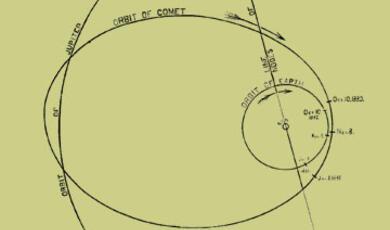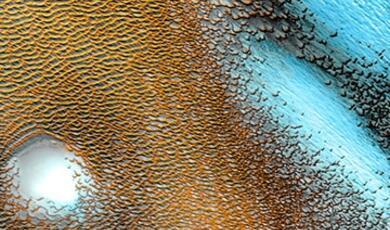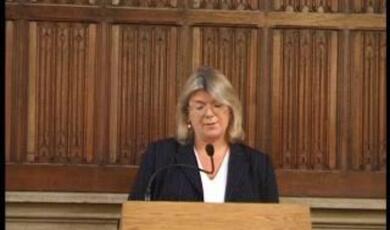Pulsars, Microwave Ovens and the Radio Sky
Share
- Details
- Text
- Audio
- Downloads
- Extra Reading
There have been two major revolutions in how we look at the sky - the shift beyond the optical to other wavelengths, particularly the radio, and the increasing attention paid to how objects change over time.
We start with the discovery of pulsars by Jocelyn Bell Burnell, explore how a microwave oven bamboozled astronomers, and discuss the latest research on Fast Radio Bursts, mysterious events detected in galaxies billions of light-years away.
Any Further Questions? Podcast
Listen to our follow-up podcast with Professor Lintott via the Audio tab or on Spotify & Apple
Download Text
Pulsars, Microwave Ovens and The Radio Sky
Professor Chris Lintott
21 February 2024
On the 18th December 2020, Ian Sample, the science editor of the Guardian broke a huge story. Astronomers working for the Breakthrough Listen project - the largest and best funded search for extraterrestrial intelligence in history - had found a signal that appeared to be coming from a planet in orbit around the nearest star to the Sun, Proxima Centauri. Detected by the venerable Parkes Telescope in Australia (previously most famous as 'The Dish' which carried signals from the Apollo 11 mission to the world), the signals had been found in data taken in April and May the previous year.
Though Sample's article does point out that there is likely some quotidian explanation. it also says that the signal, covering a narrow range of wavelengths and moving with the planetary system that we know exists around this nearby star, fits exactly what Breakthrough and other SETI astronomers have been looking for for decades. A discovery of intelligence on our next-door star system would surely indicate that it is common in the cosmos. The signal, named BLC-1 (Breakthrough Listen Candidate 1) was the most convincing find for decades: could this be evidence of abundant nearby intelligent life at last?
Radio signals have been the expected tool of choice for chatty interstellar communication since at least 1960, when the first discussions and experiments took place at West Virginia's Green Bank Observatory. To creatures with a bias towards shorter wavelengths, maybe this seems surprising. Immersed in our visual culture, it's easy to miss the fact that the Universe shines in many different wavelengths. This is in some sense a practical thing; though snakes see in the infrared, at longer wavelengths than we can, and many animals use the ultraviolet at shorter wavelengths that we can perceive, there isn't a creature on the planet with radio telescopes for ears. The reason is due to fundamental physics: the resolution - the sharpness of an image produced by a telescope - depends on the size of the dish or mirror involved, and the wavelength of light. Longer wavelengths - and for the kind of radio waves we're talking about in astronomy we're considering a wavelength of centimetres or even meters - require larger instruments, making radio waves an impractical choice for life. When we meet aliens, they will likely see much as we do[1].
However, as William Herschel found when mapping the galaxy (see lecture 1), visible light is limited on galactic scales. It is easily absorbed by dust, meaning that we can only see a small fraction of the Milky Way at these wavelengths. (Consider, for example, the dark patches that cross the Milky Way in the naked eye sky, blocking more distant stars). Only by switching to the longer wavelengths of radio can we properly map the galaxy.
The discovery of radio astronomy's utility was essentially an accident[2]. Its first pioneer, Karl Jansky, was investigating sources of interference that were getting in the way of commercial radio transitions. Aiming to localise the source of the noise, he mounted a series of antennae on a rotating platform - a device which quickly became known amongst his co-workers at Bell Labs as Jansky's merry-go-round. Swinging it round, he discovered that while most of the background noise picked up by his equipment could be traced back to distant thunderstorms, there remained a persistent contribution that could not be matched to anything terrestrial.
At first, Jansky thought that the source of the radio waves he was detecting must be the Sun, but as he continued with his measurements over the course of a year, it seemed to move away. Eventually, it became clear that the source was keeping sidereal time, rising four minutes later each day and thus keeping pace with the stellar sky; Jansky, realising that he had detected radio waves coming from the distant cosmos, called it 'Star Noise'.
Though the commercial interest in following up this discovery was lacking, the discovery did attract a modest amount of attention at the time. Jansky's Star Noise was broadcast on public radio, where it was heard by a budding radio engineer in Illinois, one Grote Reber. Reber was instantly inspired, and wrote to pretty much every centre of astronomical research in the US, hoping for a job. The responses he got made it clear that even in the 1930s, professional astronomers still considered serious science to be the preserve of optical telescopes. The language of radio astronomy, which had more in common with the physics lab than the observatory, left them cold, and no-one had a job or encouragement for Reber.
Nor did Bell labs, but undeterred he pressed on, constructing his own instrument in his garden in Wheaton, a suburb of Chicago. This was the first proper radio telescope, a fully steerable dish which could be swung around the sky (it was also used to hang Reeber's mother's washing, at some cost to its utility as a scientific instrument). Commuting to work in the city during the day, Reber would spend the evenings observing, with the weekends dedicated to processing his results.
It took many months of painstaking effort to make sense of what his instrument was telling him, but it was worth the wait. Reber produced the first proper map of the radio sky, which showed for the first time the structure of our Milky Way galaxy. Thanks to the ability in the radio to see through the dust clouds with otherwise block our view, he saw our galaxy's spiral arms clearly. He wrote up his results, and sent them to the Astrophysical Journal, then as now the leading publication in the field[3]. Rather than accept or reject the paper, the editor Subrahmanyan Chandrasekha (of black hole fame) arranged for a delegation of astronomers to visit Reber - an inspection visit so that the great and the good of astronomy could meet the unknown engineer from Illinois who wrote of mapping the galaxy.
As far as I know, this is unprecedented. The delegation visited Wheaton, and Reber's paper was eventually published, albeit only after the editor had stripped from it the interpretation of the results. Observations could be done by talented amateurs working with newfangled equipment, but scientific deduction, it seemed, should remain the province of serious men in universities. Reber was about as impressed as you'd expect - he said the astronomers had left his results to 'moulder', but he had discovered profound truths about the structure of our galaxy.
Perhaps the most significant discovery about the Milky Way had already been made by Jansky. The bright source that he found was located in the constellation of Sagittarius, in the approximate location of the centre of the galaxy. In the nomenclature of the new science, it was giving the designation Sag A, but its nature remained mysterious until at least the 1970s. Then, observations with a new generation of instruments which were able to combine observations from multiple dishes, providing an image much sharper than could be achieved by any one instrument on its own.
These observations showed that, whatever the source of radio waves at the centre of our galaxy was, it must be compact - something like the size of our solar system. One of the discoverers of this compact source, Bruce Balick, later named in Sag A* - the star, borrowed from chemistry, denoting excitment! Later observations, in the infrared and the optical, showed that the object must be massive as well as compact; early estimates amounted to three million solar masses. The monitoring, in particular, of the movements of galactic centre stars around Sag A* increasingly refined this measurement, and that of the density of the object, by the mid 1990s leaving no sensible interpretation other than that the centre of our galaxy is home to a supermassive black hole.
More recently, by coordinating simultaneous observations from telescopes around the world, including the South Pole, the Event Horizon Telescope project has managed to create a picture of the immediate environment around Sag A*. The glowing orange doughnut, surround the black hole's shadow, represents the glow of a bright disk of material in orbit around the black hole, with a remarkable match to theoretical predictions for the behaviour of matter and light in such extreme conditions. Monitoring, which is aimed at measuring the variability of this disk and hence of activity around the black hole itself, is now underway.
There was a long road between Jansky's first observations, and the technical sophistication required to produce the iconic EHT image. In the time that development was taking place, new observatories, techniques and - most importantly - more powerful computers have transformed our ability to record the radio sky. In many ways, the main change wrought by these developments is the realisation that the radio universe is filled with transient, changing objects.
The most famous of these are the pulsars, discovered by Jocelyn Bell-Burnell observing with a Cambridge array designed and built by the group led by her supervisor, Anthony Hewish in the 1960s. By then, many hundreds of individual, apparently compact sources of radio waves had been identified across the sky, but their nature was not yet clear. The main aim of Jocelyn's PhD was to measure their scintillation ('twinkling', in less technical language) and thus distinguish distant, point-like sources from nearer sources with larger angular extents. Observing late one evening, she noticed what she later described as a little patch of 'scruff' on the chart produced by the telescope's pen recorder, an apparent signal in a part of the sky which had not previously been noticed.
Not for the first or last time in the long history of radio astronomy, perseverance was key. Jocelyn realised she'd seen the 'scruff' before and searched back over months of charts to find its previous appearance. The rapidly varying source responsible appeared in the same part of the sky on this prior occasion, and it looked like nothing that had been seen before. The regular pulses, received every 1.3 seconds, were so consistent they appeared unnatural; with tongues firmly in cheek, the Cambridge team called their source 'LGM1' - 'Little Green Men 1' - and Jocelyn remembers cycling home from the observatory on the edge of Cambridge upset that aliens might have appeared to disrupt her PhD.
Whether natural or the product of intelligence, the rapidity with which the pulses arrived told astronomers that the source must be compact. A model of these 'pulsars' soon emerged in which they were powered by dense neutron stars, the remnants of the cores of massive stars which have thrown off their outer layers as a supernova. Such objects are small - perhaps only a few tens of kilometres across, and incredibly dense. Because they retain much of the star's angular momentum, they rotate fast, and their powerful magnetic fields can drive jets of material which are aligned with the magnetic pole of the object.
When the beam of such a jet sweep across the Earth, our telescopes record a pulse. Pulsars are thus cosmic lighthouses, and like their nautical equivalents they can be useful for navigation. The Pioneer probes, launched to investigate Jupiter and Saturn in the 1970s but now heading into deep space, carry plaques which locate the position of the Solar System in the galaxy relative to 14 pulsars, each one identified by their unique period. Pulsars are remarkably good clocks, and so the idea is that aliens finding it will, at least in theory, be able to work out where we are. (We now understand better than astronomers in the 1970s did that pulsars do change their periods over time, becoming slower over time. Aliens planning to find us via our crude maps best hurry - or have a long record of the historical behaviour of pulsars so they can work out when we launched the spacecraft).
The precision of pulsar timing has led to their use in a variety of astronomical applications. The first planets identified beyond the Solar System were discovered around a pulsar in 1992 because their gravitational pull on the much more massive object at the centre of the system causes small but regular changes in its pattern of pulses. While not unique, it seems such pulsar planets are rare, and we do not yet know whether they are survivors, worlds which have come through the dramatic cataclysm that produced the pulsar, or whether they form from the debris produced by the supernova, in which case they might represent a second generation of planets. Observations of a famous double system - with a pulsar in orbit around a neutron star - provided evidence for the presence of gravitational waves, ripples in space time itself caused by the movement of massive objects (more on which next year).
Larger scale efforts to use pulsar timing have recently paid off, too. Observatories around the world have been carrying out long term monitoring of pulsars in the hope of detecting a background of gravitational waves at much longer wavelengths than can be found with conventional observatories. The idea is that, rather than being calm, the space that we find ourselves embedded in is, in fact, a broiling sea, affected by ripples caused by the collision of black holes in distant galaxies. As radio waves from pulsars travel through space, their arrival time at Earth is slightly changed, and the net effect of these changes can be detected.
It is a remarkably sensitive experiment, requiring immense care and attention to detail. As the observatories being used are on the Earth, understanding the motion of our planet through space is of crucial importance; an earlier, promising looking detection turned out to be due to the fact that the position of Jupiter, whose gravity tugs on the Earth and the other planets of the Solar System, was not known with sufficient precision. The arrival of the Juno probe in orbit around the giant planet fixed this, and one side effect of the pulsar timing efforts has been the determination of the location of the barycentre of the Solar System, the place where the gravitational pull of the Sun and planets balances, to within a few hundred meters.
More dramatic events have also been seen in the radio sky. Amongst the most famous was the detection, between 2008 and 2015 at Parkes, of what were called Perytons - short bursts of no more than a few milliseconds in duration that appeared to come from all over the sky. As anything within the galaxy (or the Solar System, for that matter) would be expected to lie along a plane, this was evidence that the bursts, whatever they were, came from the distant universe, making them amongst the most powerful events in the history of the cosmos.
It should be said that not everyone thought perytons had a cosmic origin; the name, coined by a scientist who was investigating them, suggests a man-made origin (a peryton in Greek mythology being a stag that casts a human shadow). The fact that telescopes other than Parkes could not see them was suspicious, as was the fact that they seemed to come from a large area of sky, rather than from a point source. Over time, it also became apparent that Perytons tended to appear at lunchtime; their source was a malfunctioning pair of nearly thirty-year old microwave ovens in the observatory's visitor centre; a fault meant that opening the door before the timer expired emitted a burst of radio waves which the telescope could detect.
Malfunctioning microwaves demonstrate the extreme sensitivity of modern radio telescopes to interference from terrestrial sources, as well as from satellites and spacecraft in low Earth orbit. Attempting to find transients - things that change - on the radio is like trying to pick out a whisper in a crowded, busy room at a party. Yet we are increasingly good at this; there has been much excitement in the last fifteen years about so-called fast radio bursts, initially discovered during searches for pulsars in archival data.
These are short bursts of emission at many different frequencies which emit more power in a few milliseconds as the Sun does in a few days. Most seem to come from distant galaxies and a few, which repeat, have been localised to particular systems. Hundreds a year are now found, mostly by the Canadian CHIME experiment which, despite being built initially for cosmology, at least one has been seen coming from a source within the Milky Way and another, relatively nearby, seems to have come from a magnetar, a type of active neutron star that has also been implicated in producing powerful bursts of gamma-rays seen in high energy light.
In truth, it is too early to say definitively what FRBs really are. Everything from colliding black holes, exotic particles and - inevitably - aliens has been invoked to explain what these distant bursts are, a task made more complicated by the few that have been observed to repeat. Thinking up something that can not only produce a bright burst of radio waves to be seen over extragalactic distances, but also survive the process to do so a matter of months or years later, is hard. The truth is that, more than ninety years after Jansky's discovery of star noise, we are still at the stage of understanding what sorts of object lurk in the radio sky, producing a taxonomy of what we can detect.
It's a process that will be rapidly accelerated by the construction of the Square Kilometre Array, a vast set of telescopes which will spread over southern Africa and western Australia. While the final form of the array may not appear for many decades, the nice thing about radio telescopes is that even a few are useful, and observations with precursor arrays such as MeerKAT in South Africa, with 64 dishes, is already observing.
MeerKAT is studying the centre of the galaxy, showing complex structures that span this most interesting region of the galaxy. Notable in particular are the presence of long radio filaments which thread the region, and whose origin is not yet clearly understood. It is also, thanks to a new instrument provided by Breakthrough Listen, doing SETI - not targeting likely planets, but listening as the telescope goes about its business, checking each observation for a signal that might betray the presence of intelligent life.
Which brings me back to BLC-1. A careful search through the Parkes archives eventually found several similar signals, including many detected when the telescope was not pointed at Proxima Centauri. That particular search thus ended not with the discovery of alien life, but with the signal's attribution to something human-made - most likely a nearby radio transmitter, malfunctioning and being picked up by the dish's sensitive instruments. Nonetheless, the BLC-1 story - and the science that's flowed from studying black holes, pulsars, FRBs and the rest of the radio sky in the last century or so - reminds us how rich in interest and possibility the Universe is when we look beyond the visible.
© Professor Chris Lintott, 2024
Further Reading
Breakthrough Listen Candidate 1
https://www.theguardian.com/science/2020/dec/18/scientists-looking-for-aliens-investigate-radio-beam-from-nearby-star
The mystery was resolved by Sheikh et al: https://arxiv.org/abs/2111.06350
History of Radio Astronomy
Much of this material is included in my book, Our Accidental Universe, which is out next month (!). See also G. Verschuur: The Invisible Universe: The Story of Radio Astronomy, Spinger, 2015.
K. I. Kellermann, “Grote Reber (1911–2002): A Radio Astronomy Pioneer,” in The New Astronomy: Opening the Electromagnetic Window and Expanding Our View of Planet Earth: A Meeting to Honor Woody Sullivan on his 60th Birthday, ed. W. Orchiston, vol. 334, Astrophysics and Space Science Library (Springer, 2005),
https://link.springer.com/chapter/10.1007/1-4020-3724-4_4.
See also W. Sullivan, ed., The Early Years of Radio Astronomy: Reflections Fifty Years after Jansky’s Discovery (Cambridge University Press, 2010).
Sag A
The crucial paper identifying Sag A* as a compact source is Balick & Brown 1974: https://ui.adsabs.harvard.edu/abs/1974ApJ...194..265B/abstract
Background to the EHT observations of Sag A* is given here: https://aasnova.org/2022/05/12/first-image-of-the-milky-ways-supermassive-black-hole/ along with links to the crucial papers.
Pulsars
Jocelyn’s detection of pulsars is described in a Cambridge historical note here: https://www.cam.ac.uk/stories/journeysofdiscovery-pulsars
A first hand description of the discovery of pulsar planets is here: https://ui.adsabs.harvard.edu/abs/2012NewAR..56....2W/abstract
The original binary pulsar discovery paper, by Hulse & Taylor, is very readable: https://ui.adsabs.harvard.edu/abs/1975ApJ...195L..51H/abstract
And there’s background from when they were awarded the Nobel Prize here:
https://ui.adsabs.harvard.edu/abs/1975ApJ...195L..51H/abstract
Microwaves and Perytons are discussed in Petroff et al 2015: https://arxiv.org/abs/1504.02165
FRBs:
Summed up by XKCD here: https://xkcd.com/2886/ and in a recent review by the pioneers of the field: https://arxiv.org/abs/2107.10113
MeerKaT galactic centre images described here: https://arxiv.org/abs/2201.10541
© Professor Chris Lintott, 2024
[1] This argument is due in part to paleontologist Simon Conway Morris.
[2] See ‘Our Accidental Universe’ by me, out next month!
[3] Disclaimer: I'm one of its editors.
Further Reading
Breakthrough Listen Candidate 1
https://www.theguardian.com/science/2020/dec/18/scientists-looking-for-aliens-investigate-radio-beam-from-nearby-star
The mystery was resolved by Sheikh et al: https://arxiv.org/abs/2111.06350
History of Radio Astronomy
Much of this material is included in my book, Our Accidental Universe, which is out next month (!). See also G. Verschuur: The Invisible Universe: The Story of Radio Astronomy, Spinger, 2015.
K. I. Kellermann, “Grote Reber (1911–2002): A Radio Astronomy Pioneer,” in The New Astronomy: Opening the Electromagnetic Window and Expanding Our View of Planet Earth: A Meeting to Honor Woody Sullivan on his 60th Birthday, ed. W. Orchiston, vol. 334, Astrophysics and Space Science Library (Springer, 2005),
https://link.springer.com/chapter/10.1007/1-4020-3724-4_4.
See also W. Sullivan, ed., The Early Years of Radio Astronomy: Reflections Fifty Years after Jansky’s Discovery (Cambridge University Press, 2010).
Sag A
The crucial paper identifying Sag A* as a compact source is Balick & Brown 1974: https://ui.adsabs.harvard.edu/abs/1974ApJ...194..265B/abstract
Background to the EHT observations of Sag A* is given here: https://aasnova.org/2022/05/12/first-image-of-the-milky-ways-supermassive-black-hole/ along with links to the crucial papers.
Pulsars
Jocelyn’s detection of pulsars is described in a Cambridge historical note here: https://www.cam.ac.uk/stories/journeysofdiscovery-pulsars
A first hand description of the discovery of pulsar planets is here: https://ui.adsabs.harvard.edu/abs/2012NewAR..56....2W/abstract
The original binary pulsar discovery paper, by Hulse & Taylor, is very readable: https://ui.adsabs.harvard.edu/abs/1975ApJ...195L..51H/abstract
And there’s background from when they were awarded the Nobel Prize here:
https://ui.adsabs.harvard.edu/abs/1975ApJ...195L..51H/abstract
Microwaves and Perytons are discussed in Petroff et al 2015: https://arxiv.org/abs/1504.02165
FRBs:
Summed up by XKCD here: https://xkcd.com/2886/ and in a recent review by the pioneers of the field: https://arxiv.org/abs/2107.10113
MeerKaT galactic centre images described here: https://arxiv.org/abs/2201.10541
© Professor Chris Lintott, 2024
Part of:
This event was on Wed, 21 Feb 2024
Support Gresham
Gresham College has offered an outstanding education to the public free of charge for over 400 years. Today, Gresham College plays an important role in fostering a love of learning and a greater understanding of ourselves and the world around us. Your donation will help to widen our reach and to broaden our audience, allowing more people to benefit from a high-quality education from some of the brightest minds.


 Login
Login







